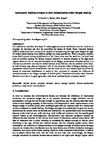Asymptotic residual stresses in butt-welded joints under fatigue loading
| dc.contributor.author | Ferro, P | |
| dc.contributor.author | Berto, F | |
| dc.contributor.author | James, Neil | |
| dc.date.accessioned | 2016-07-28T14:45:38Z | |
| dc.date.available | 2016-07-28T14:45:38Z | |
| dc.date.issued | 2016-06-01 | |
| dc.identifier.issn | 0167-8442 | |
| dc.identifier.issn | 1872-7638 | |
| dc.identifier.uri | http://hdl.handle.net/10026.1/5128 | |
| dc.description.abstract |
If a weld toe is modelled as a sharp V-notch angle, the stress distribution near the notch tip is singular. Its intensity can then be quantified by means of Notch Stress Intensity Factors (NSIF), which have been proven to be capable of summarising the high-cycle fatigue strength of welded joints having very different global and local geometries. In presence of a singular residual stress field near the weld toe, the local load ratio is modified making the fatigue strength sensitive to residual stresses in the high-cycle regime. However, for an accurate estimation of the fatigue performance of welded joints, it is necessary to consider not only the initial residual stress field but also its variation under load, as both of these may play an important role. In this work the effect of fatigue loading on the asymptotic residual stress redistribution near the weld toe of a butt-welded joint is studied by means of numerical simulations. A model is then proposed to estimate the influence of residual stresses on the fatigue strength of welded joints. Experimental results taken from the literature were found in good agreement with those predicted by the proposed model. | |
| dc.format.extent | 114-124 | |
| dc.language | en | |
| dc.language.iso | en | |
| dc.publisher | Elsevier BV | |
| dc.subject | Notch stress intensity factor | |
| dc.subject | Residual stress | |
| dc.subject | Strain energy density | |
| dc.subject | Thermo-mechanical problem | |
| dc.subject | Welded joint | |
| dc.title | Asymptotic residual stresses in butt-welded joints under fatigue loading | |
| dc.type | journal-article | |
| dc.type | Journal Article | |
| plymouth.author-url | http://gateway.webofknowledge.com/gateway/Gateway.cgi?GWVersion=2&SrcApp=PARTNER_APP&SrcAuth=LinksAMR&KeyUT=WOS:000374357500014&DestLinkType=FullRecord&DestApp=ALL_WOS&UsrCustomerID=11bb513d99f797142bcfeffcc58ea008 | |
| plymouth.volume | 83 | |
| plymouth.publication-status | Accepted | |
| plymouth.journal | THEORETICAL AND APPLIED FRACTURE MECHANICS | |
| dc.identifier.doi | 10.1016/j.tafmec.2016.02.002 | |
| plymouth.organisational-group | /Plymouth | |
| plymouth.organisational-group | /Plymouth/Faculty of Science and Engineering | |
| plymouth.organisational-group | /Plymouth/Faculty of Science and Engineering/School of Engineering, Computing and Mathematics | |
| plymouth.organisational-group | /Plymouth/Users by role | |
| plymouth.organisational-group | /Plymouth/Users by role/Academics | |
| dcterms.dateAccepted | 2016-01-20 | |
| dc.rights.embargodate | 2017-2-22 | |
| dc.identifier.eissn | 1872-7638 | |
| dc.rights.embargoperiod | 12 months | |
| rioxxterms.versionofrecord | 10.1016/j.tafmec.2016.02.002 | |
| rioxxterms.licenseref.uri | http://www.rioxx.net/licenses/under-embargo-all-rights-reserved | |
| rioxxterms.licenseref.startdate | 2016-06-01 | |
| rioxxterms.type | Journal Article/Review |


